Comments / Questions (33)
![]() Anna wrote:
Anna wrote:
Ich verstehe nicht, wie ich ein ordentliches Muster schaffen soll. Bin bei A2. 131:24 geht nicht auf und so verschiebt sich alles, wenn ich eine Reihe beende, dann bin ich ganz woanders, nicht am Pfeil, aber da soll ich doch jede Reihe starten oder nicht? Das wird ein großes Durcheinander.
21.11.2025 - 20:22DROPS Design answered:
Liebe Anna, so stricken Sie A.2: 1 Randmasche, die 5 letzten Maschen A.2, dann 4 Mal die 24 Maschen und endlich die 21 ersten Masche A.2, 1 Randmasche = 1+5+96+21+1=131. Bei den Rückreihen lesen Sie das Diagram links nach rechts, am Anfang der Rückreihe beginnen Sie mit der 21. Masche (die letzte Masche bei der Hinreihe), dann lesen Sie das Diagram rechts nach links und endlich die 5 ersten Maschen ab rechts. Viel Spaß beim Stricken!
24.11.2025 - 07:59
![]() Emily wrote:
Emily wrote:
I'm working pattern DROPS 255-17 Pattern li-180 in Med. I don't understand how to do the left front sholder. Purl 1 row from wrong side, then work as follows from right side: 1 edge stitch in garter stitch, Work the last 4 last stitches in A.3 1-0-1-1-1-1 time in total, work A.3 over the next 32-40-40-40-48-56 stitches and finish with 1 edge stitch. What does this mean?
18.10.2025 - 21:29DROPS Design answered:
Hi Emiliy, what size do you make?
19.10.2025 - 09:35
![]() Anne wrote:
Anne wrote:
I’m on the back piece, starting A2. Can you explain what it means to start at your size arrow (large)? Do you start there and then continue at beginning of pattern row to finish that line? Thanks!
08.10.2025 - 16:19DROPS Design answered:
Hi Anne, For your size, you start at the arrow on the left-hand side of the first row, work to the left to the end of the diagram then continue the round with the first stitch (still on the first row in the diagram) and work left. Repeat this until you have worked to the end of the first round on the jumper. Then begin the next round on row 2 in the diagram, again starting at the arrow. Regards Drops Team.
09.10.2025 - 12:03
![]() Julia wrote:
Julia wrote:
Couldn’t this be worked in the round?
26.09.2025 - 19:31
![]() Alya wrote:
Alya wrote:
Hi, I am currently working on the back piece. Pattern says, "work A.1 until 2 stitches remain, work first stitch in A.1 (so that pattern begins and ends the same)". I am confused about determining the first stitch on the WS. Is the first stitch for the WS on the far left (which, when viewed from the RS, it's on last stitch/far left)?
15.09.2025 - 14:13DROPS Design answered:
Dear Alya, the first stitch should be the first stitch of A.1 that you worked on this row, so that the chart starts in one stitch (for example the leftmost stitch on the WS) and ends with that same leftmost stitch. From here on, you will work over this stitch as shown in the chart (so don't look for the rightmost/leftmost square every time but just check how the square above this stitch is worked). Happy knitting!
22.09.2025 - 01:13
![]() Margaret wrote:
Margaret wrote:
Hi! I'm currently working on the back piece and knitting pattern A.2. It says to continue on working this pattern until "the piece measures 20-21-22-23-24-25 cm from cast-on edge". Do I measure the piece from the cast-on edge of the shoulders part or from the middle of the back piece where I cast on stitches for the back? Thanks!
19.08.2025 - 11:04DROPS Design answered:
Dear Margaret, after this you should work the armholes so you can check the size chart; the piece measures 20-21-22-23-24-25 cm from the cast on edge on the shoulders, down to the armhole. So the measurements should also be taken from the cast on edge on the shoulders. Happy knitting!
19.08.2025 - 21:04
![]() Alya wrote:
Alya wrote:
"Continue A.2 and cast off at the beginning of every row in each side: 2 stitches 1 time, and 1 stitch 3 times =145 stitches. Finish with 1 row from wrong side", Which part should I do this pattern at the row of chart? How to do this cast off? cause I still didn't understand.
04.03.2025 - 15:19DROPS Design answered:
Dear Alya, just continue A.2 as before, making sure to not displace pattern (it should continue as before, beg and end of rows will just start a different way because of cast-off stitches), then cast off 2 stitches at the beg of next 2 rows (2 sts from RS and 2 sts from WS), then cast off 1 stitch at the beg of next 6 rows (1 st 3 times on each side); the last row of A.2 worked will depend on your tension in height, just make sure when working front piece that you end with the same row. Happy knitting!
05.03.2025 - 08:08
![]() Anja Nouwen wrote:
Anja Nouwen wrote:
De hoeveelheid rode garen van karisma is voor medium aangegeven op 200 gram. Dit is niet voldoende omdat de boord ook met rood is gebreid. Hiervoor heb je nog 50 gram extra voor nodig.
24.02.2025 - 20:20
![]() Alya wrote:
Alya wrote:
Yeah, I mean, now I'm working in Back Piece. The pattern says "work A.1 until 2 stitches remain, work first stitch in A.1" I'm confused in which row of chart should I work, Is it on top of A. 1 (Wine red) or not... Thanks
17.02.2025 - 13:11DROPS Design answered:
Dear Alya, diagrams are read from bottom up, so start at the very bottom and read diagrams from the right side from the right towards the left and from the wrong side from the left towards the right. Read more about diagrams here. Happy knitting!
17.02.2025 - 16:09
![]() Alya wrote:
Alya wrote:
Hello, is it when working on the remaining 2 stitches at the end of the diagram (top: wine red)?
13.02.2025 - 08:08DROPS Design answered:
Dear Alya, could you specify your question? Which chart are you talking about? What 2 remaining stitches? Happy knitting!
17.02.2025 - 00:29
Nordic Flower#nordicflowersweater |
|||||||
 |
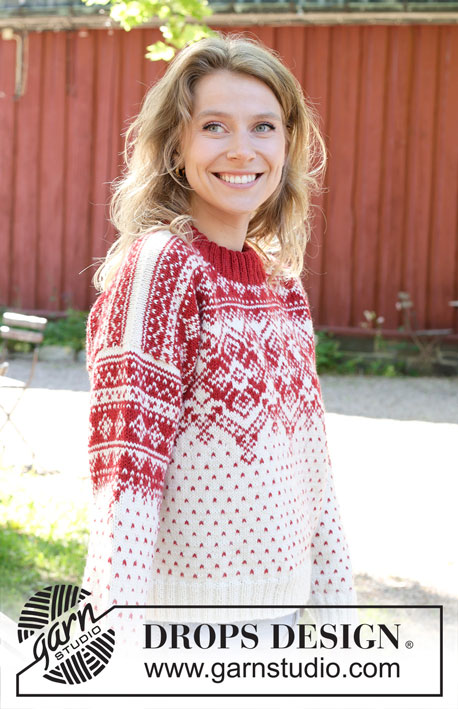 |
||||||
Knitted jumper in DROPS Lima or DROPS Karisma. Piece is knitted top down with Nordic pattern and double neck edge. Size: S - XXXL
DROPS 255-17 |
|||||||
|
---------------------------------------------------------- EXPLANATION FOR THE PATTERN: ---------------------------------------------------------- GARTER STITCH (when working back and forth): Knit on all rows, i.e. knit from right side and knit from wrong side. 1 ridge vertically = knit 2 rows. PATTERN: See diagrams A.1 to A.4. Diagrams show all rows in pattern seen from the right side. Work pattern in stocking stitch. INCREASE TIP: Increase 1 stitch by making 1 yarn over, on next row/round work yarn over twisted to avoid holes. Then work the new stitches in stocking stitch. DECREASE TIP: Decrease 1 stitch on each side of marker thread as follows: Work until 3 stitches remain before marker thread and knit 2 together, knit 2 (marker thread is in the middle of these 2 stitches), slip 1 stitch knitwise, knit 1, pass slipped stitch over stitch worked (= 2 stitches decreased). KNITTING TIP: To avoid the knitting tension to tighten when working pattern, it is important not to tighten the strands on back side of piece. Use a larger needle size when working pattern try needed. When there are large gaps in the pattern, twine the yarn on the back of piece. ---------------------------------------------------------- START THE PIECE HERE: ---------------------------------------------------------- JUMPER - SHORT OVERVIEW OF THE PIECE: In this pattern needles of different length have been used, begin with fitting length for number of stitches and switch as needed. Work piece back and forth on needle. Finish front and back piece separately. Work top down, down to armholes, slip parts together and work in the round over all stitches. Pick up stitches for sleeves around the armholes. Then work sleeves downwards in the round on needle. Finish by picking up stitches around the neck and working a double neck edge. BACK PIECE: RIGHT SHOULDER: Work back and forth on circular needle. Cast on 38-42-46-46-54-62 stitches on circular needle size 4 mm with DROPS Lima in colour off white or DROPS Karisma in colour off white. Purl 1 row from wrong side, then work 4 rows PATTERN - read explanation above - as shown in A.1, with 1 edge stitch in GARTER STITCH in each side – read explanation above. The edge stitches are always worked in garter stitch. Put piece aside, and work the left shoulder. LEFT SHOULDER: Cast on 38-42-46-46-54-62 stitches on circular needle size 4 mm with DROPS Lima in colour off white or DROPS Karisma in colour off white. Purl 1 row from wrong side, then work 4 rows pattern as shown in A.1, with 1 edge stitch in garter stitch in each side. On next row slip shoulders together for back piece as explained below. BACK PIECE: Work next row as follows from right side: Work 5th row in A.1 over stitches from left shoulder, cast on 39-39-39-47-47-47 new stitches on row with colour red/wine red, work 5th row in A.1 over stitches on right shoulder = 115-123-131-139-155-171 stitches. Read KNITTING TIP! Work 1 edge stitch as before, work A.1 until 2 stitches remain, work first stitch in A.1 (so that pattern begins and ends the same), 1 edge stitch as before. When A.1 has been worked, continue as follows: 1 edge stitch, work A.2 until 1 stitch remain, work 1 edge stitch as before - see start arrow for your size! Pattern will not fit one whole repetition in the sides but there is one whole repetition of A.2 in the middle of row. When piece measures 20-21-22-23-24-25 cm from cast-on edge, insert 1 marker in each side of piece. Note which row in pattern this is. Continue A.2 and cast off at the beginning of every row in each side: 2 stitches 1 time, and 1 stitch 3 times = 105-113-121-129-145-161 stitches. Finish with 1 row from wrong side. Cut the yarn and put piece aside, and work front piece as explained below. FRONT PIECE: LEFT SHOULDER: Cast on 38-42-46-46-54-62 stitches on circular needle size 4 mm with DROPS Lima in colour off white or DROPS Karisma in colour off white. Purl 1 row from wrong side, then work as follows from right side: 1 edge stitch in garter stitch, Work the last 4 last stitches in A.3 1-0-1-1-1-1 time in total, work A.3 over the next 32-40-40-40-48-56 stitches and finish with 1 edge stitch. On 14th-14th-16th-16th-18th-18th row in diagram begin increase for neck, cast on new stitches at the end of every row from wrong side as follows: 1 stitch 1 time, 2 stitches 2 times and 3 stitches 1 time = 46-50-54-54-62-70 stitches, work the increased stitches in the pattern. When increases are done, cut the yarn. Last row worked is from wrong side. Put piece aside, and work the right shoulder. RIGHT SHOULDER: Cast on 38-42-46-46-54-62 stitches on circular needle size 4 mm with DROPS Lima in colour off white or DROPS Karisma in colour off white. Purl 1 row from wrong side, then work as follows from right side: 1 edge stitch in garter stitch, work A.1 over the next 32-40-40-40-48-56 stitches, work the first 4 stitches in A.1 1-0-1-1-1-1 time, finish with 1 edge stitch in garter stitch. On 13th-13th-15th-15th-17th-17th row in diagram begin increase for neck, cast on new stitches at the end of every row from right side as follows: 1 stitch 1 time, 2 stitches 2 times and 3 stitches 1 time = 46-50-54-54-62-70 stitches, work the increased stitches in the pattern. Work last row from wrong side. On next row slip shoulders together for front piece as explained below. FRONT PIECE: Work next row from right side as follows: Work next row in A.1 over stitches from right shoulder, cast on 23-23-23-31-31-31 new stitches on row with colour red/wine red, continue A.1 over stitches from left shoulder = 115-123-131-139-155-171 stitches. Read KNITTING TIP! Work 1 edge stitch, A.1 until 2 stitches remain, work first stitch in A.1 (so that pattern begins and ends the same), 1 edge stitch in garter stitch. When A.1 has been worked, continue as follows: 1 edge stitch as before, A.2 until 1 stitch remains, work 1 edge stitch as before - see start arrow for your size! Pattern will not fit one whole repetition in the sides but there is one whole repetition of A.2 in the middle of row so that the pattern is symmetrical. When piece measures 20-21-22-23-24-25 cm from cast-on edge, insert 1 marker in each side of piece - make sure that this is the row as on back piece. Continue A.2 and cast off at the beginning of every row in each side: 2 stitches 1 time, and 1 stitch 3 times = 105-113-121-129-145-161 stitches. Finish with 1 row from wrong side, do not cut the yarn. BODY: On next row from right side work parts together as follows: Work 105-113-121-129-145-161 stitches from front piece (continue A.2 as before as far as the pattern), work the next 105-113-121-129-145-161 stitches from back piece (continue A.2 as before as far as the pattern). There are now 210-226-242-258-290-322 stitches on needle. Continue in the round with A.2. NOTE! The pattern will not fit in each side under sleeve but work as far as possible towards each side, make sure that there is at least 1 stitch with colour off white in each side when working dots. When the pattern is done, repeat the top 8 rounds in pattern (marked with x). Work as before until piece measures 25-26-27-27-28-29 cm from where the parts were put together, adjust so that a few rounds without dots have been worked before rib. Now finish the piece with colour off white. On next round begin rib while AT THE SAME TIME increasing 42-46-50-50-62-66 stitches evenly on needle = 252-272-292-308-352-388 stitches. Switch to circular needle size 3 mm and work rib (= knit 2/purl 2 - remember increase). Cast off when rib measures 6-6-6-7-7-7 cm. Jumper measures 54-56-58-60-62-64 cm. ASSEMBLY: Sew the shoulder seams. SLEEVES: Work sleeves in the round from armhole and downwards on circular needle size 4 mm. Pick up from right side 84-88-92-96-100-106 stitches along armhole – use colour off white, begin at the marker at the bottom of armhole and pick up stitches until marker in the other side. Stitches cast off in each side of body are sewn together when finish. Insert 1 marker thread at beginning of row. Insert in addition 1 marker in one of the 2 middle stitches on round (= approx. mid on top of sleeve). Marker thread mid under sleeve is used when decreasing under sleeve and marker mid on top of sleeve should be used to count where to begin pattern under sleeve. Work 1 round in stocking stitch with colour off white. Then work pattern, i.e. work A.4 around the sleeve - stitch with arrow in A.4 should fit stitch with marker mid on top of sleeve - count out towards marker thread where pattern should begin mid under sleeve (the pattern will not fit mid under sleeve). When sleeve measures 3 cm from marker on the shoulder, decrease mid under sleeve – read DECREASE TIP and decrease as follows: Decrease 2 stitches every 3-2½-2½-2-2-1½ cm 13-14-14-15-16-18 times in total = 58-60-64-66-68-70 stitches. When A.4 has been worked one time vertically, repeat the last 8 rounds (marked with x in diagram) Work until sleeve measures 42-41-41-39-36-33 cm from marker, finish with a few rows without dots. Now finish with colour off white. Switch to double pointed needles size 3 mm and work rib (= knit 2/purl 2) while AT THE SAME TIME increasing 10-12-12-10-12-14 stitches evenly on 1st round = 68-72-76-76-80-84 stitches. When rib measures 6-6-6-7-7-7 cm cast off. DOUBLE NECK EDGE: Use circular needle size 3 mm and colour red/wine red. Begin at one shoulder seam and pick up approx. 120 to 136 stitches around the neck), number of stitches must be divisible by 4. Work rib (= knit 2/purl 2) for 9 cm. Switch to circular needle size 4 mm and cast off. ASSEMBLY: Fold the rib down on inside of garment. Fasten rib to get a double neck edge. To avoid a tight neck edge that sticks out it is important to keep the seam elastic. Sew the opening under each sleeve. |
|||||||
Diagram explanations |
|||||||
|
|||||||
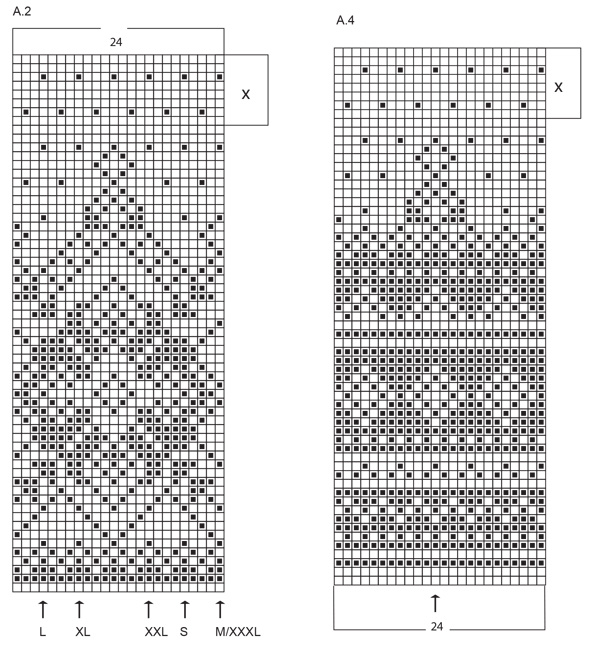 |
|||||||
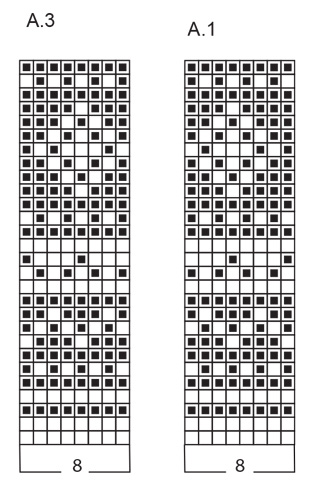 |
|||||||
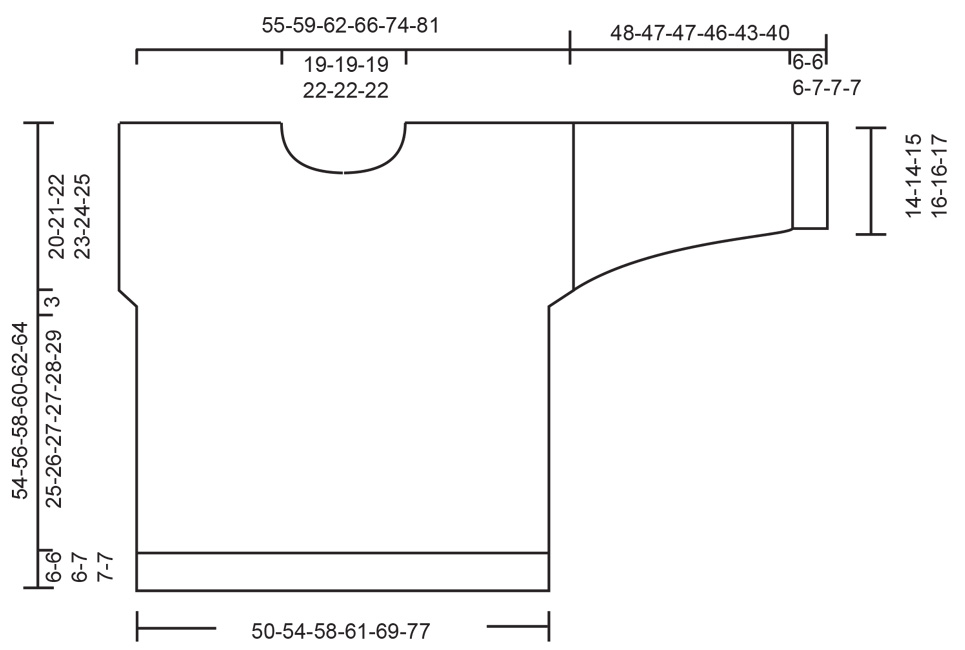 |
|||||||
Have you finished this pattern?Tag your pictures with #dropspattern #nordicflowersweater or submit them to the #dropsfan gallery. Do you need help with this pattern?You'll find 30 tutorial videos, a Comments/Questions area and more by visiting the pattern on garnstudio.com. © 1982-2025 DROPS Design A/S. We reserve all rights. This document, including all its sub-sections, has copyrights. Read more about what you can do with our patterns at the bottom of each pattern on our site. |
|||||||







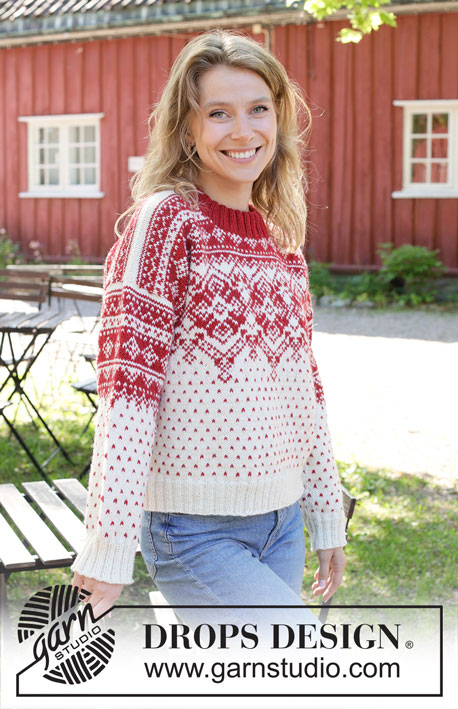
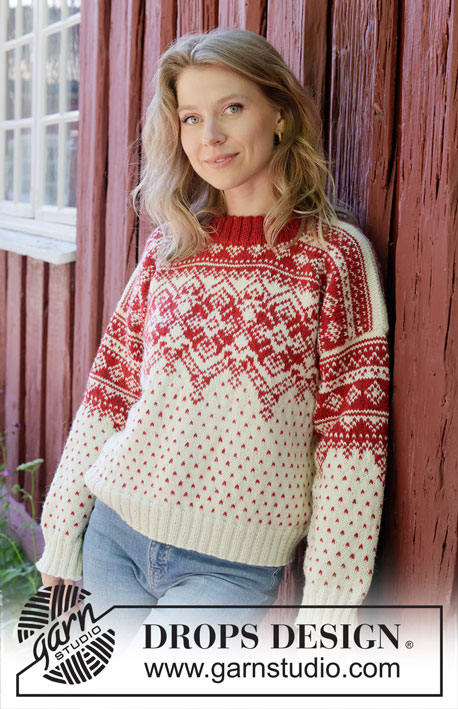


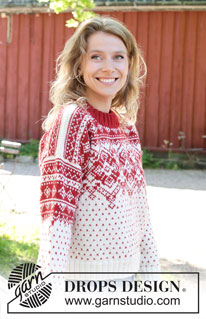
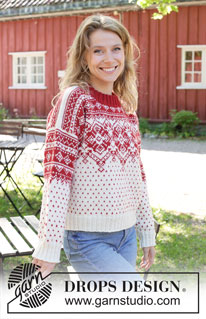
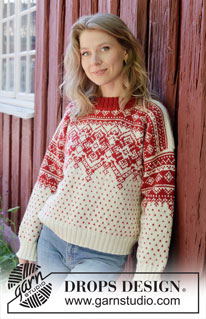
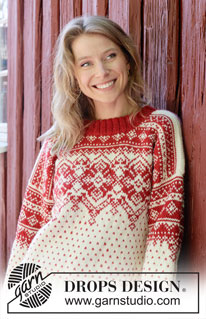
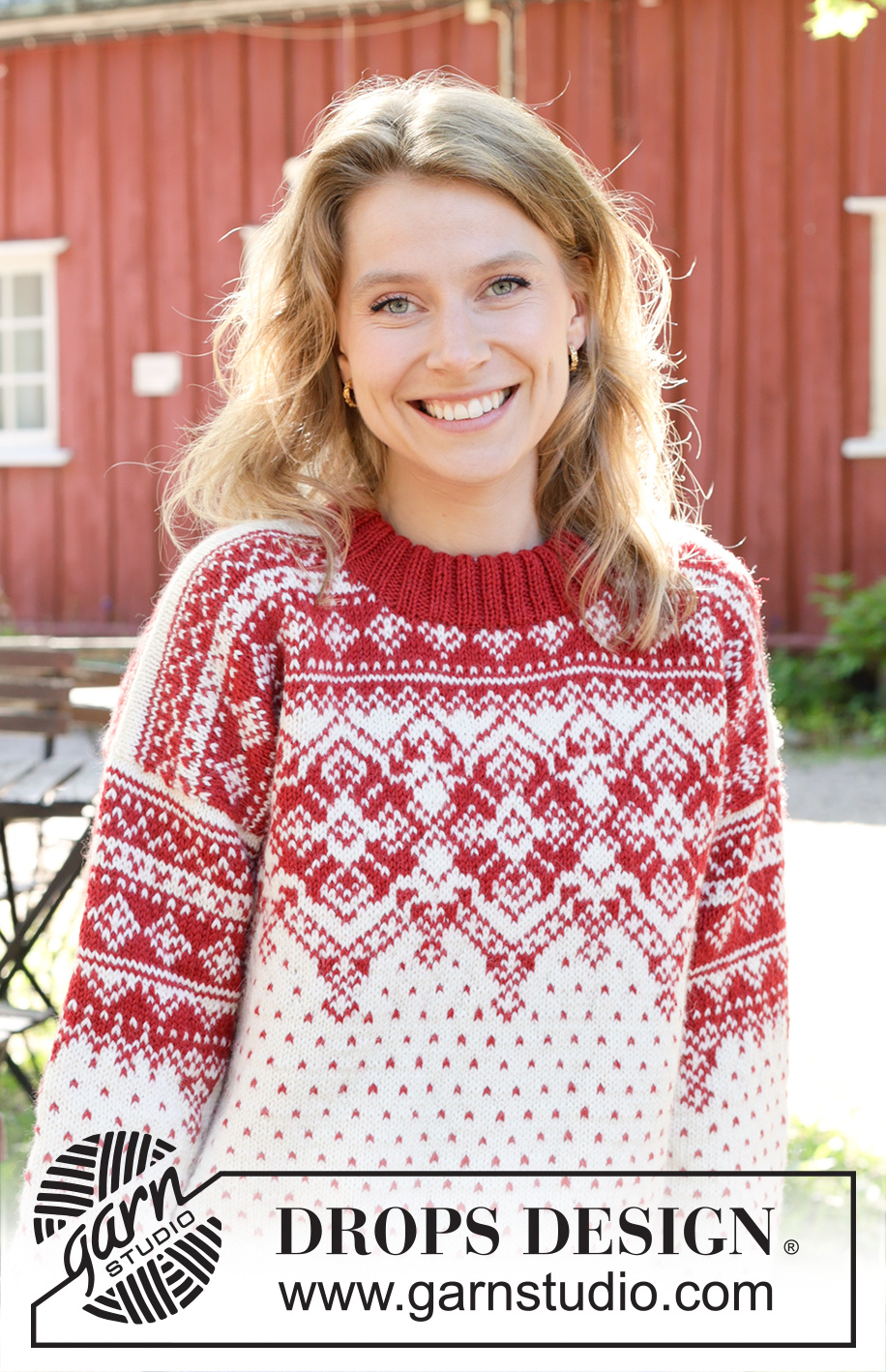
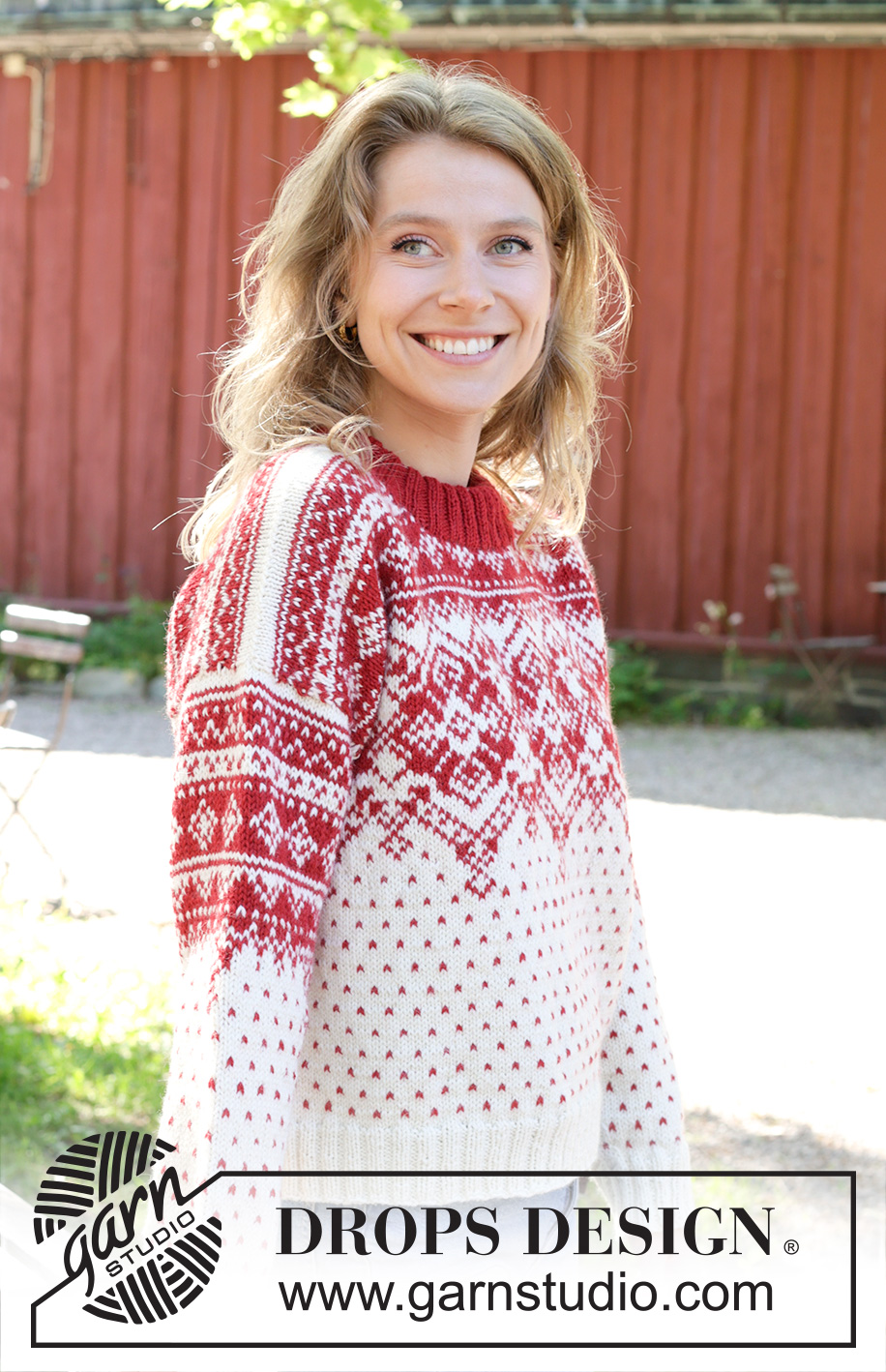
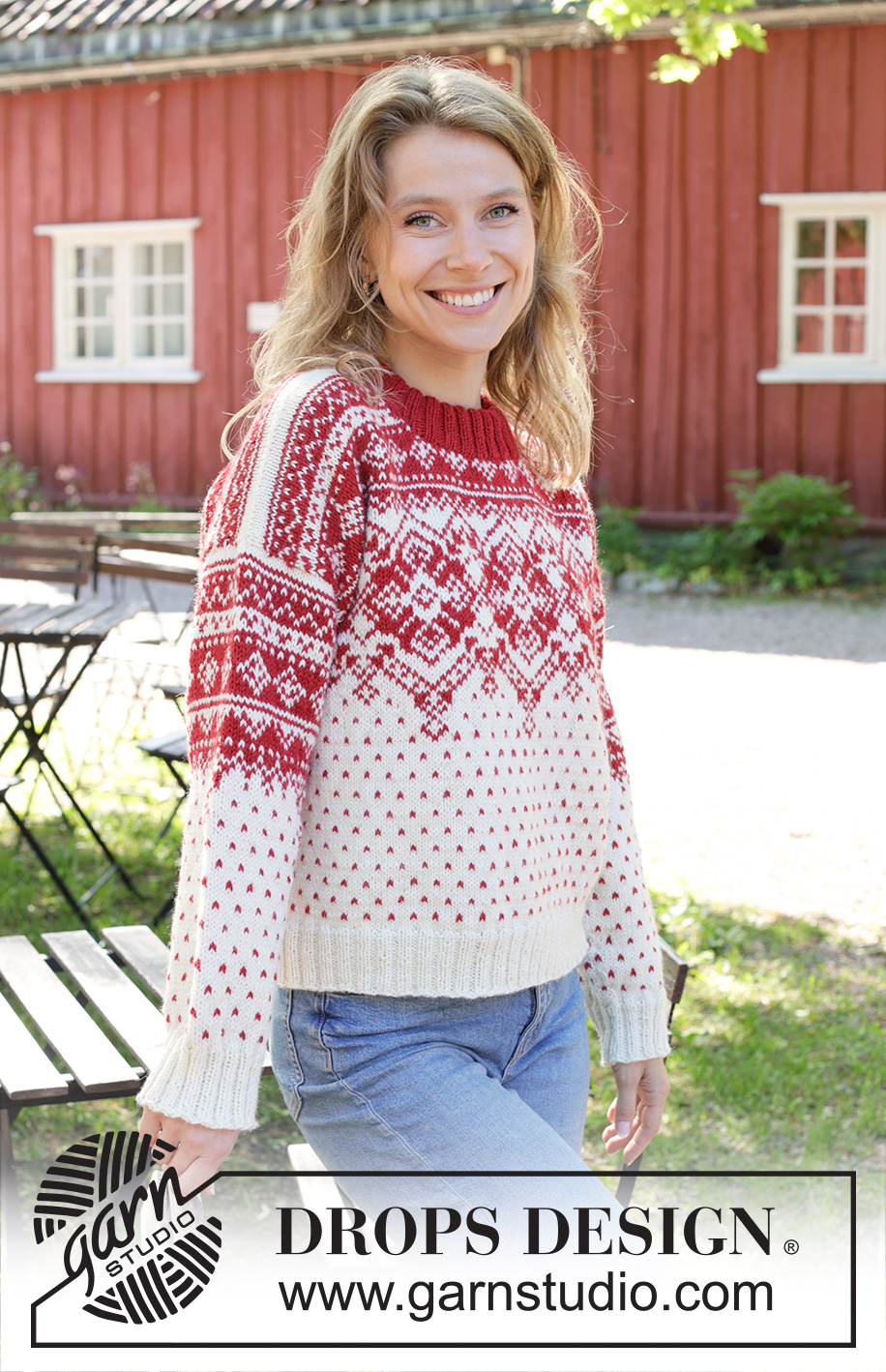
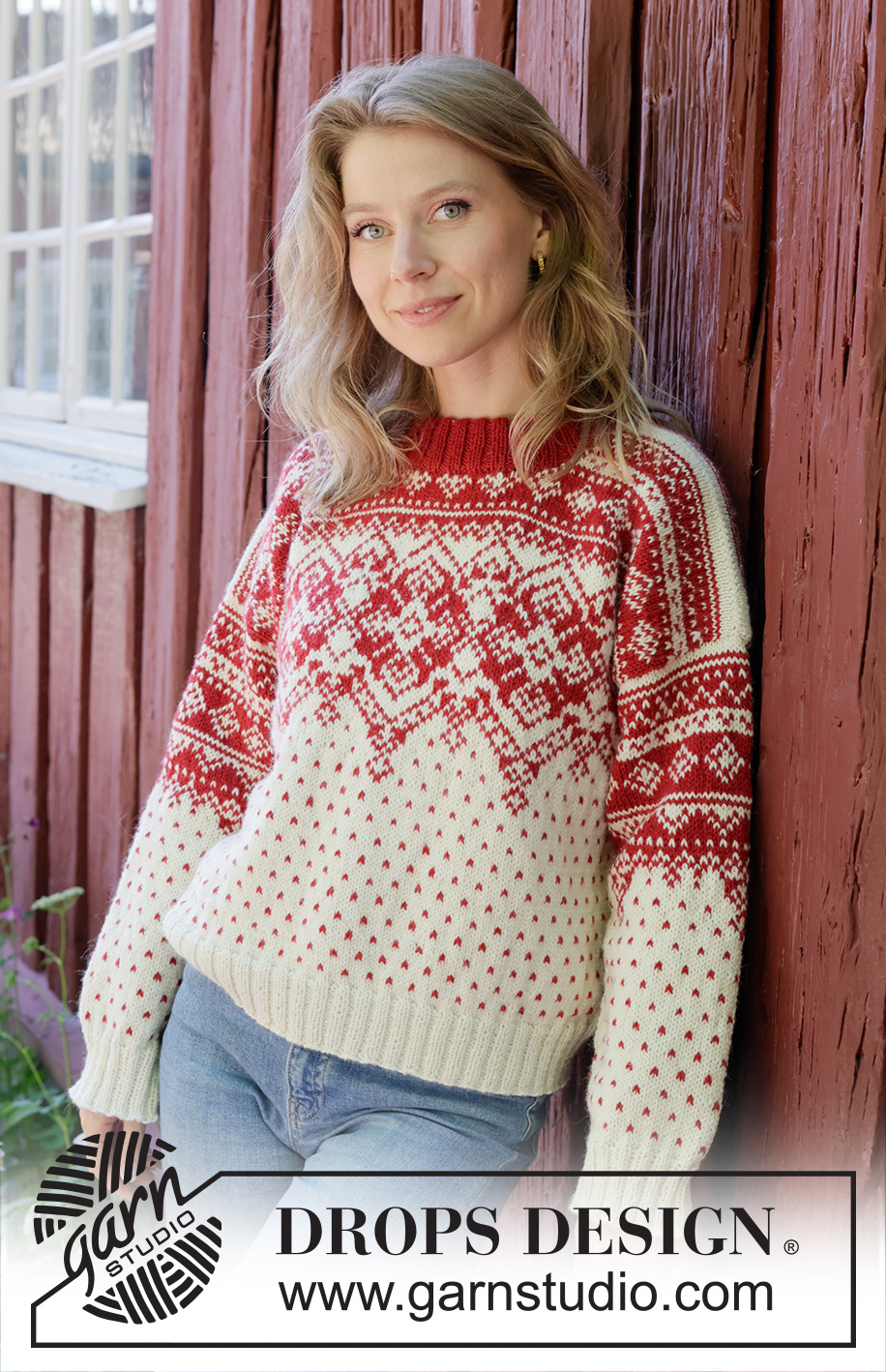
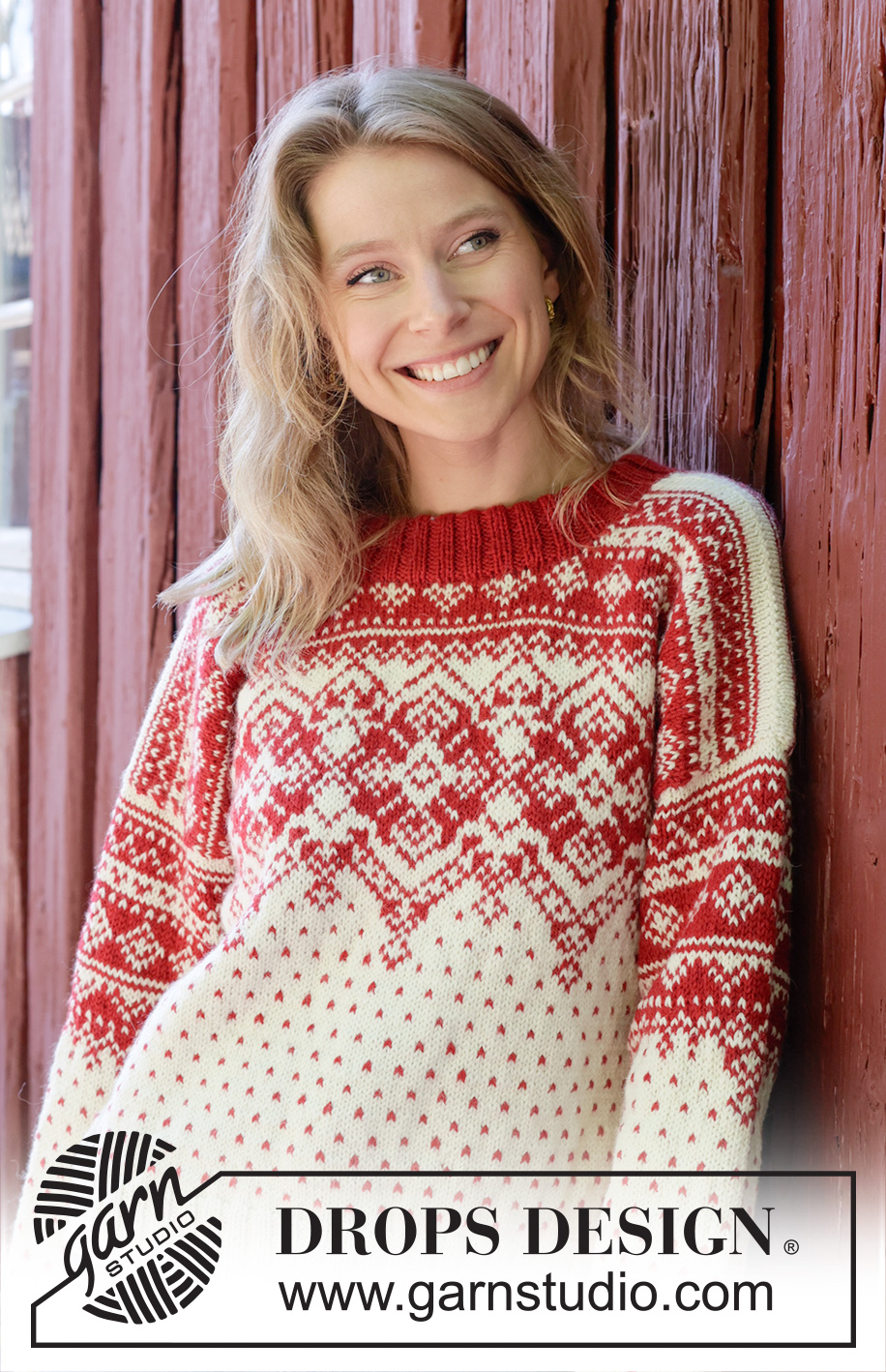


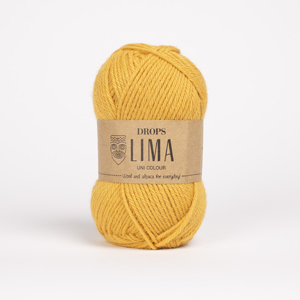
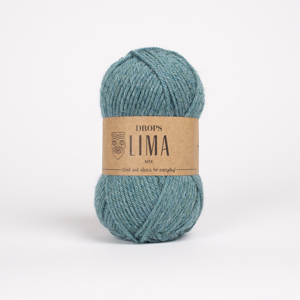




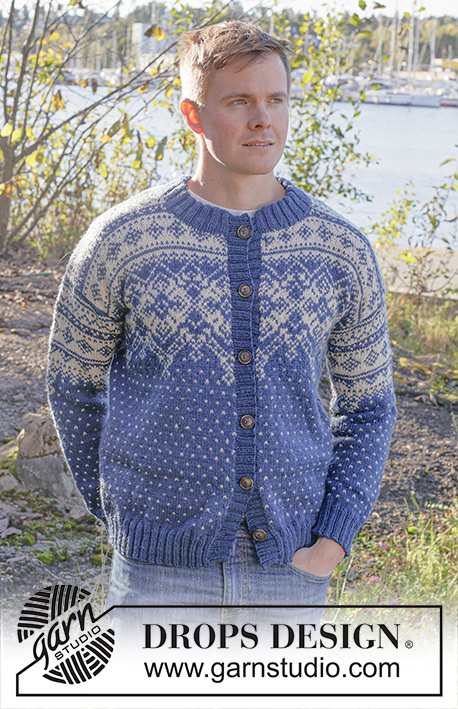
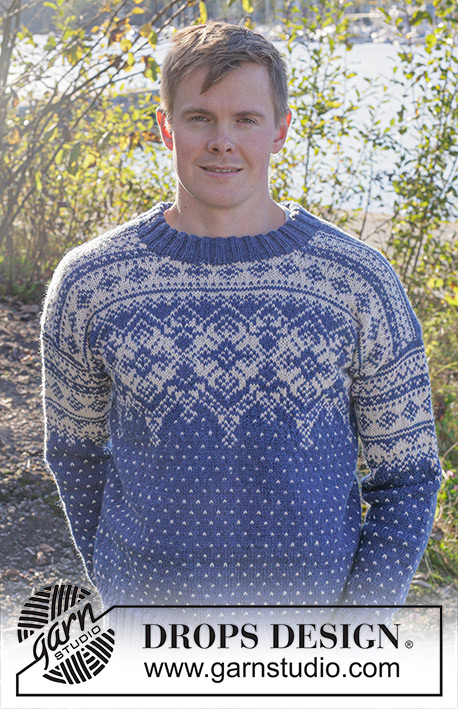


































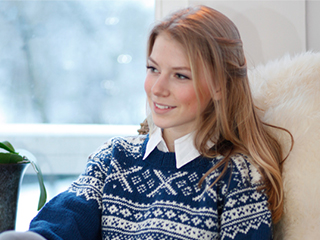












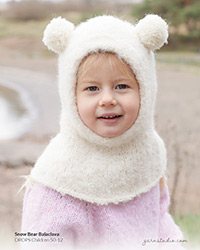
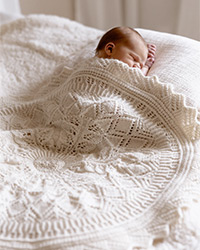
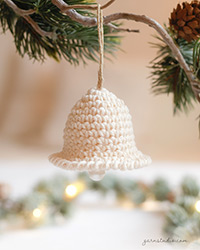
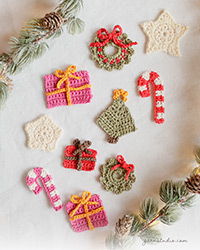

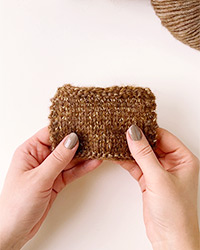
Post a comment to pattern DROPS 255-17
We would love to hear what you have to say about this pattern!
If you want to leave a question, please make sure you select the correct category in the form below, to speed up the answering process. Required fields are marked *.